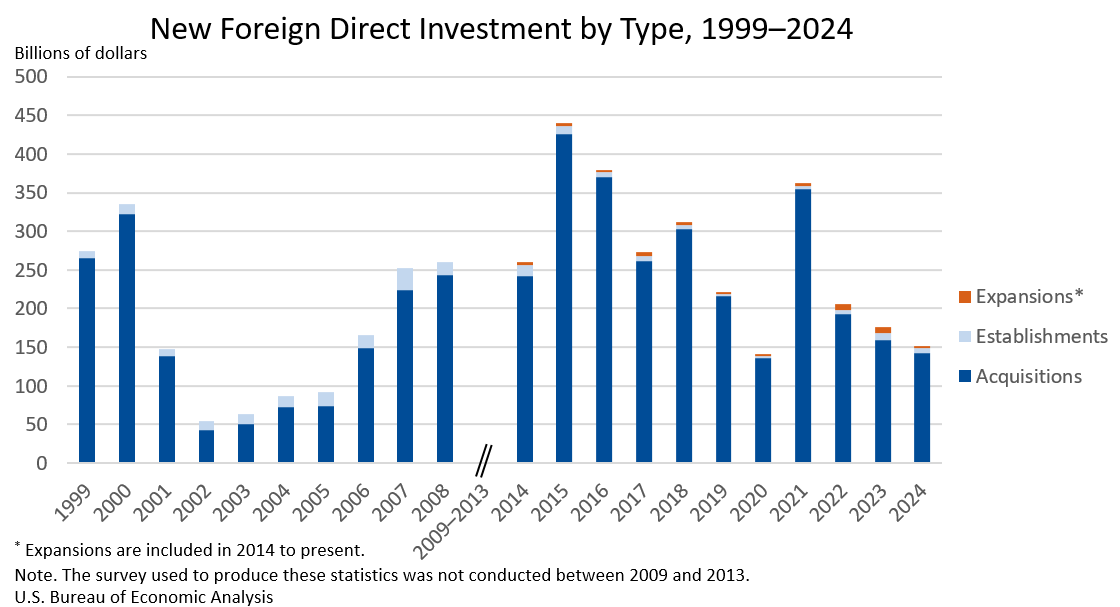Bureau of Economic Analysis
New Foreign Direct Investment in the United States, 2024
Expenditures by foreign direct investors to acquire, establish, or expand U.S. businesses totaled $151.0 billion in 2024, according to preliminary statistics released today by the U.S. Bureau of Economic Analysis. Expenditures decreased $24.9 billion, or 14.2 percent, from $176.0 billion (revised) in 2023 and were below the annual average of $277.2 billion for 2014–2023. As in previous years, acquisitions of existing U.S. businesses accounted for most of the expenditures.
Principal Federal Economic Indicators
Noteworthy
- 2025 News Release Schedule
- Innovation at BEA
- 2025 Annual Updates
- New! Services Trade Data for More Countries
- Data Tool: Trade in Value Added
- Distribution of State Personal Income
- Updated: RIMS II Regional Multipliers
- Arts and Culture
- Space Economy
- FDI Now in State BEARFACTS
- Quick Guide: Price Indexes
The Latest
Personal Income and Outlays, September 2015
Personal income increased $18.6 billion, or 0.1 percent, and disposable personal income (DPI) increased $19.2 billion, or 0.1 percent, in September, according to the Bureau of Economic Analysis. Personal consumption expenditures (PCE) increased $15.6 billion, or 0.1 percent. In August, personal income increased $54.9 billion, or 0.4 percent, DPI increased $49.5 billion, or 0.4 percent, and PCE increased $44.2 billion, or 0.4 percent, based on…
GDP Increases in Third Quarter
Real gross domestic product (GDP) increased 1.5 percent in the third quarter of 2015, according to the “advance” estimate released by the Bureau of Economic Analysis. In the second quarter, real GDP increased 3.9 percent.
GDP highlights The third-quarter increase in real GDP mainly reflected a rise in consumer spending. Spending on services increased, notably on health care. Spending on nondurable and durable goods also rose.
Gross Domestic Product, 3rd quarter 2015 (advance estimate)
Real gross domestic product -- the value of the goods and services produced by the nation’s economy less the value of the goods and services used up in production, adjusted for price changes -- increased at an annual rate of 1.5 percent in the third quarter of 2015, according to the "advance" estimate released by the Bureau of Economic Analysis.
Guest Blog: Spending on Disease Treatment has Increased, but Good Health Outcomes Have Too
by Cynthia Cox Kaiser Family Foundation
(This post, from the Kaiser Family Foundation, is based on BEA’s new health care statistics released earlier this year.)
Coming Soon: Webinar for BE-180 Survey Respondents
The Bureau of Economic Analysis (BEA) will be conducting an informational webinar on Thursday, October 22, at 1 p.m., to discuss the BE-180 Benchmark Survey of Financial Services Transactions between U.S. Financial Services Providers and Foreign persons. Topics of discussion will include:
August 2015 Trade Gap is $48.3 Billion
The U.S. monthly international trade deficit increased in August 2015 according to the U.S. Bureau of Economic Analysis and the U.S. Census Bureau. The deficit increased from $41.8 billion in July (revised) to $48.3 billion in August, as exports decreased and imports increased. The previously published July deficit was $41.9 billion. The goods deficit increased $6.6 billion from July to $67.9 billion in August. The services surplus increased…
U.S. International Trade in Goods and Services, August 2015
U.S. Census Bureau U.S. Bureau of Economic Analysis NEWS U.S. Department of Commerce * Washington, DC 20230 U.S. INTERNATIONAL TRADE IN GOODS AND SERVICES AUGUST 2015 The U.S. Census Bureau and the U.S.
BEA's Factory Factoids in Honor of Manufacturing Day
U.S. factories do their part to keep the U.S. economy humming. Did you know that manufacturing accounts for 12 percent of overall U.S. economic activity as measured by Gross Domestic Product? The Bureau of Economic Analysis produces a slew of economic statistics on how manufacturing and other U.S. industries are performing and impact the economy. Given that Oct.
State Personal Income: Second Quarter 2015
State personal income grew 0.9 percent on average in the second quarter of 2015, after growing 0.8 percent in the first quarter. Personal income grew in every state except Oklahoma in the second quarter. In the first quarter, personal income grew in 34 states. Second-quarter personal income growth rates ranged from zero in Oklahoma to 1.5 percent in the state of Washington.
For more information, read the full report.
State Quarterly Personal Income, 1st quarter 2012 - 2nd quarter 2015; State Annual Personal Income, 2012 - 2014
State personal income grew 0.9 percent on average in the second quarter of 2015, after growing 0.8 percent in the first quarter, according to estimates released today by the U.S. Bureau of Economic Analysis. Personal income grew in every state except Oklahoma in the second quarter. In the first quarter, personal income grew in 34 states. Second-quarter personal income growth rates ranged from zero in Oklahoma to 1.5 percent in the state of…




